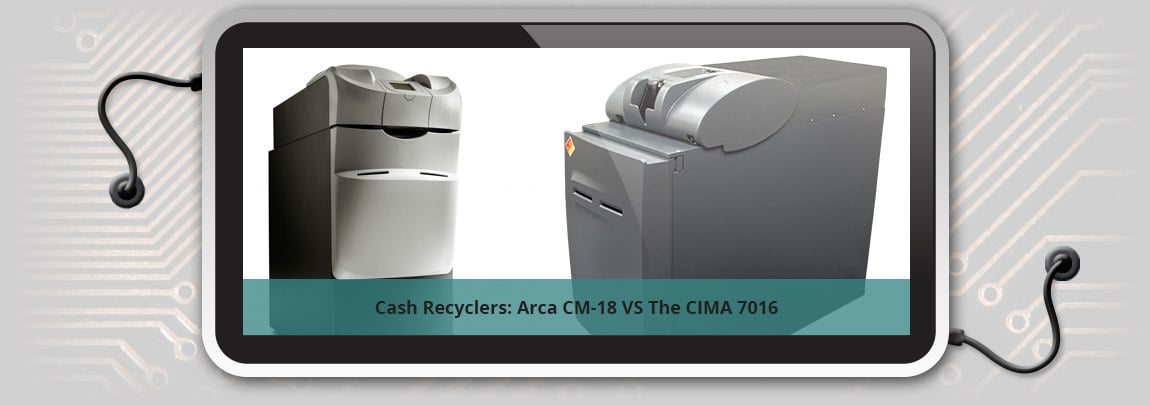Cash Recyclers: Arca CM-18 VS The CIMA 7016

Why should I automate with a cash recycler?
Sure cash recyclers can be big investment for a small to mid-size financial institution. That's exactly why it's important to get the facts, count the cost, and understand the benefits returned. Did you know that a cash recycler offers the capacity to cover the labor of nearly 1.5 employees? Increased cash management efficiency is the biggest advantage that cash recyclers offer financial institutions. When banks and credit unions select the right machines to meet their needs, a cash recycler can actually pay for itself in short order (18-24 months or less).
What kind of ROI can I expect? What kind of results can a small to mid-sized financial institution expect?
Cash recyclers can dramatically reduce operating expenses and speed up cash-in and cash-out transactions. They also reduce cash levels in drawers, reducing exposure and can eliminate the need for cash drawers altogether.
Here's what you can expect a cash recycler to do:
- Automate both sides of cash transactions
- Manage cash inventory
- Reduce or eliminate balance discrepancies
- Maximize the value of employees where they are most useful – with customers instead of handling cash
Institutions have reported 30% to 50% efficiency gains with the use of a cash recycler. When it comes to time-consuming vault transactions, a cash recycler manages the process in single control what can typically take two employees 10-20 minutes to accomplish. The cash recycler also saves an average of 35 seconds per cash-out transaction, which is great for those peak times when the lines are backing up.
Whether a financial institution is looking to change its customer experience format, or is positioning for growth cash recyclers are an investment that makes good business sense. The biggest question remains, "Which cash recycler makes the most sense for your institution?"
Dare to Compare
Carefully assess your needs and how the right cash recycler will integrate with the software structure and physical workflow of your banking processes in order to determine where you will receive the best value per dollar spent. Consider how each machine will function for your employees and how it will accommodate improved customer service. While this ROI may not appear as obvious on a spreadsheet, considering these important issues may ultimately make the biggest difference in the long run. A little investigation prior to purchase can pay huge dividends -- not only in terms of actual money saved, but also in terms both of customer and employee satisfaction.
The Arca CM-18 versus the CIMA 7016
Arca CM-18: PROS
- All cash is dispensed from a secure safe
- No need to sort, count or dispense bills – they are immediately verified and sorted by denomination
- Offers 8, 10, and 12 RSM units – modular upgrades from 8 to 10 or 12
- User indicator lights allow two tellers to use the cash recycler at one time
- Multi-media user interface instructs customers of functionality, offers inventory display and instructs bank employees how to troubleshoot when errors occur.
- Simple USB or network integration
- Sharp machine design with a small footprint
- Ability to use as a discriminator for cash deposit counting
Arca CM-18: CONS
- Capacity = only 4,000 to 6,000 notes based on configuration
- No continuous feed functionality – delay of 30-60 seconds in between each bundle – larger deposits take a lot longer than CIMA
- Feeder has been a known weakness of device
- Currency can curl being RSM based
- On-site tech support typically done by large third party companies
- Pricing varies from mid $30,000s to low $40,000s with coin and integration
CIMA 7016: PROS
- All cash dispensed from a secure safe
- Extremely high capacity = 9,600 notes
- No need to sort, count or dispense bills – they are immediately verified and sorted by denomination
- Continuous feed functionality – Allows for fastest processing of larger deposits
- Easy jam clearance
- Superior functionality – fewest times of replenishment or emptying process
- Advanced authenticity technology – BV5000 sensor is best of breed
- The same company sells, installs and services the equipment – backed by certified training
- Pricing is in the high $20,000s to mid $30,000s with coin and integration
CIMA 7016: CONS
- Simple, practical design
- US Installation base – newer product to US market so smaller reference base
- Currency can be slightly curled do to RSM storage system
Use your people where they are needed most
From a practical financial standpoint, cash recyclers make perfect sense for credit unions and small to mid-size banks. They become the behind-the-scenes workhorse to perform the important but often monotonous function of processing, verifying and securing cash. That's why the biggest advantage any financial establishment will realize with the addition of a cash recycler is greater efficiency of labor and enhanced productivity. Select the right machine and you will free up your staff to do what they do best; address the more complex issues of your customers that require and deserve direct contact with your employees.
Cash Recyclers: Arca CM-18 VS The CIMA 7016 Recommendation
If the machine being aesthetically pleasing is paramount to your institution based on branch design then I would recommend going with the CM-18. If you are looking for greater cash management capacity, faster deposit processing and larger capacity for less money than the CIMA 7016 may be your solution.
About Sean Farrell
Sean has been in the business since 2003 and always aims to be an expert on whatever solutions QDS is providing. Sean has grown into a thought leader in the space through research and company growth. Sean holds strongly to his Christian faith and uses those principles to guide the business.




